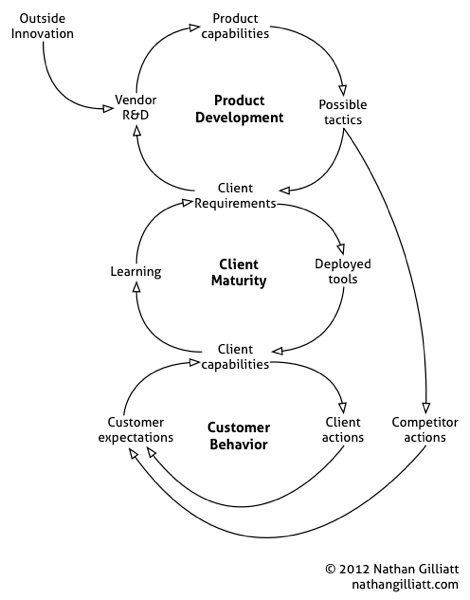Another sketch from the whiteboard
A couple of years ago, a suggestion that I develop a maturity model for social media analysis led to a different kind of model. My approach to this space has always been to explore its edges, looking for what might be next. One effect I've noticed is that change circulates through the ecosystem of companies, their customers, and their suppliers. Where change keeps coming, everyone's learning together.
A linear maturity model defines development stages toward a known destination, but in a system where everyone is learning, the destination is still unknown. We react to others, and others react to us. Change reverberates through the system, and we don't yet know what maturity looks like.
What this means in social media analysis
If social media analysis were good for one thing, we could have a simple maturity model. The products would progress toward a theoretical ideal, and clients would mature toward efficient, effective business practices. But the technology stack is built on areas of active research, new platforms are driving new consumer behaviors, more business functions are showing interest in how to use social media to do their jobs, and vendors are trying new ways to distinguish themselves.
Virtually every piece of the puzzle is moving.
Let's go to the whiteboard to see if we can visualize it.
There's a lot going on here, and this is the oversimplified version. Here's the basic dynamic: on the right, new capabilities become practices; on the left, new expectations become requirements. In the overall system, we expect more from our suppliers as we adapt to new capabilities and adopt new practices.
Think about what is being learned in each loop.
- Tool vendors combine their own R&D with new capabilities from research labs and partner companies to expand their products' capabilities, enabling new tactics for their clients, who provide feedback and new requirements based on real-world use of the products.
- Consumer-facing companies experiment with new tools and capabilities, and they learn from both operational results and customer reactions.
- Customers react to companies' online tactics, adjusting their behavior to maximize their own benefit. When they find a practice they like, they may expect other companies to mimic it.
Who's learning fastest?
We know of some unintended lessons, such as teaching customers to complain publicly for a quicker response, and redefining like. But where do we look if we want to get ahead of the market? Try these key areas:
- Outside innovation - New research and inventions may provide answers to questions you've wanted to answer.
- Product capabilities - What's possible keeps changing, but don't look only at existing suppliers. Look at adjacent markets for capabilities worth adapting to new applications.
- Client requirements - It's always worthwhile to pay attention to what companies say they'll pay for.
- Client capabilities - Watch what companies are actually using, too.
- Competitor actions - Watch early adopters for practices that may become standard. Is there a better way to do it?
- Customer expectations - How are people reacting to new business practices? What issues are being raised? What new expectations?
More ideas from the whiteboard:
I'm sharing some of the frameworks that have been hiding on my whiteboard. Want to apply them in your business? Email me.

